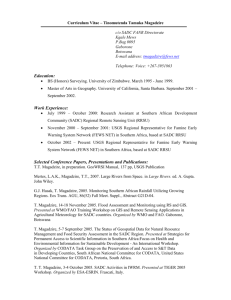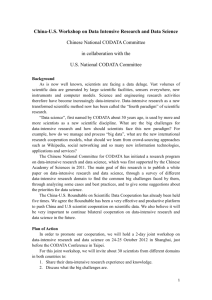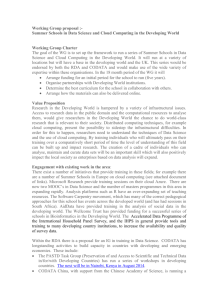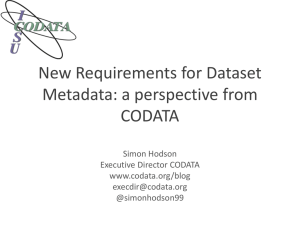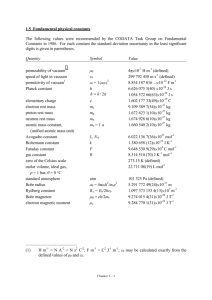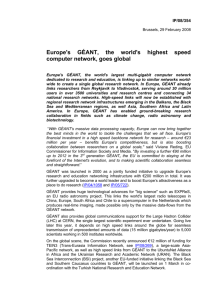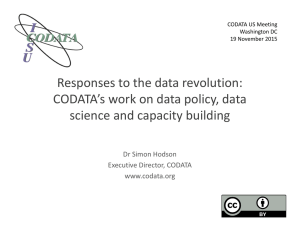Presentation
advertisement
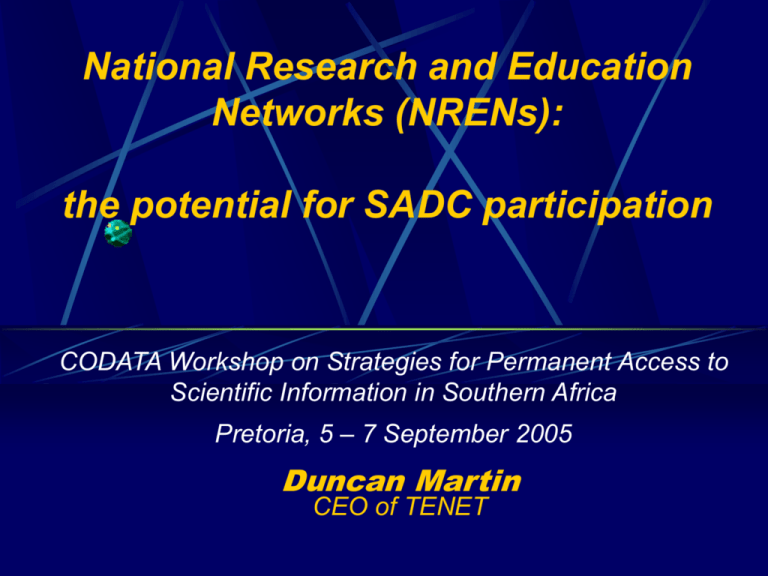
National Research and Education Networks (NRENs): the potential for SADC participation CODATA Workshop on Strategies for Permanent Access to Scientific Information in Southern Africa Pretoria, 5 – 7 September 2005 Duncan Martin CEO of TENET The origin of the NREN 1970’s: Internet started by US DoD research arm. 1980’s: US academe takes control. Free for all. Netiquette defines the rules. Email is what it’s about. Distributed, user-led management. 1990’s: Growth of the WWW. Jan Allerman gets connected. Rise of the ISP industry Intellectual property issues become important. Commercial interests vie for control. 2000’s: Commerce and governments take control. Congestion. Top level policy power passes to political and legislative levels Spam (unsolicited, bulk marketing by email) Access circuits congested by by student email and browsing Institutional budgets stretched Academe’s Response: Let’s build RENs! CODATA Workshop on Strategies for Permanent Access to Scientific Information in Southern Africa 2 So what exactly is a REN? Acronyms: REN: “Research and Education Network” NREN: “National REN” RREN: “Regional REN” (e.g NorduNET in Scandinavia) RENS are an integral part of the Internet; but provide alternative links and routes between member sites Carry only traffic passing between member sites. (“Private” networks in this sense…) Usually, members must be research and/or educational institutions May have peering agreements with other RENs Have transit agreement with “superRENs” like Géant CODATA Workshop on Strategies for Permanent Access to Scientific Information in Southern Africa 3 Who owns NRENS? Of the 34 NRENs in Europe Approx. 50% controlled by state agencies Approx 50% consortia of user institutions In the USA, there are many different RENs National scope: NSFNet, ESNet, Internet2, LambdaRail,.. State scope: CENIC, NYSERNET,.. Manifold inter-connection agreements Some, but not many, financed by federal agencies CODATA Workshop on Strategies for Permanent Access to Scientific Information in Southern Africa 4 Géant Géant – the “superREN” Initiative of (and partly funded by) the European Commission Very high-speed (up to 10 Gb/s) backbone network Inter-connects 34 European NRENs Has 7.5 Gb/s trans-Atlantic connections to Internet2 and CANARIE Has connections to APAN (Asia Pacific Academic Network) Operated by a non-profit UK company called “Dante” under contract to the EC (see www.dante.net) As a result, there’s a unique, global REN If you connect to Géant and/or to Internet2, you connect to it! The EC looks to a country’s government to identify that country’s NREN for purposes of connecting to Géant. CODATA Workshop on Strategies for Permanent Access to Scientific Information in Southern Africa 5 So: in the developed world: NRENs have arisen to ensure that advanced networking traffic is not disabled by congestion from commoditytype traffic develop next-generation networking and applications in research and higher education. (Extract from Internet2’s interconnection MoU) CODATA Workshop on Strategies for Permanent Access to Scientific Information in Southern Africa 6 In SADC, there are other roles as well…. Bandwidth is very expensive! The NREN as “bandwidth consortium” Negotiates affordable Internet access for its member institutions; Volume discounts special “holy cow” deals; lobbying government and regulators, e.g. for relaxed VSAT license conditions Share cost of connection to Géant enable participation in collaborative international research projects Be part of the global networked research community Develop ICT human capacity CODATA Workshop on Strategies for Permanent Access to Scientific Information in Southern Africa 7 The South African situation TENET is the “bandwidth consortium” that arranges general Internet access (via TELKOM) SANReN: The SA Government is creating an NREN Department of Science and Technology (DST) Driven by needs of “big e-science” projects VLBI, ALICE Project, tropical medicine Will connect to Géant; will not provide general Internet access All TENET institutions will connect, either directly or via a SANReN/TENET gateway “Connectable” institutions in other countries welcome EC very supportive In place by 1Q2006 Dedicated connection to Géant (1 Gb/s?) TENET is assisting the DST CODATA Workshop on Strategies for Permanent Access to Scientific Information in Southern Africa 8 Why is bandwidth expensive? (1) Africans bear the full cost of the long-haul connectivity to Europe and USA That’s just how the Internet developed! Johnny-come-lately pays to connect! Many countries still have a single incumbent operator protected by restrictive license regulations SADC lacks EU-type regional authority Regional bodies that do exist tend to be associations of vested interests, like the telcos and the regulators. Consumer interests are not represented. Cross-border connectivity is tightly regulated for the benefit of the incumbents. CODATA Workshop on Strategies for Permanent Access to Scientific Information in Southern Africa 9 Why is bandwidth expensive? (2) “Shareholders’ Club” model for financing submarine cables prevents competitive access Clubs are private, are not incorporated as accounting entities, and are very secretive about costs. SA’s SNO has no landing rights for traffic from SAT-3 cable There is healthy competition to provide international connectivity via satellite (VSAT), but VSAT bandwidth is inherently much more costly to provide Requires each site to install a large dish ($45,000) Prices between $2,50 and $4,00 per kb/s (one-way) per month Latency is always over 500 ms Not feasible for high bandwidths (over 100 Mb/s) Result: Pricing for cable connectivity is not cost-related Price pitched to just compete with VSAT CODATA Workshop on Strategies for Permanent Access to Scientific Information in Southern Africa 10 The University of Witwatersrand 11.3 Mb/s Internet access Cost breakdown Appox. unit cost ($ per kb/s per month) Carrier transit cost in UK $4.00 7% Long haul to UK (via SAT-3 cable) cost 63 % Transport and peering within South Africa 30 % CODATA Workshop on Strategies for Permanent Access to Scientific Information in Southern Africa 11 The University of Swaziland 192 kb/s Internet access Cost breakdown Appox. unit cost ($ per kb/s per month) Carrier transit in UK $ 12.00 2.5 % Long haul to UK (via SAT-3 cable) 21.0 % Transport and peering within South Africa 10.0 % Trans-border link: S African half-circuit 25.0 % Trans-border link: Swazi half-circuit 41 5 % CODATA Workshop on Strategies for Permanent Access to Scientific Information in Southern Africa 12 New deployments of optical fibre In many SADC countries: this is driven by Electrical power providers, who need fibre-connectivity for managing their distribution grids; and Cellular telephony operators, whose customer base has far outstripped that of the traditional fixed-line operators. In many countries, the cellular operators (including MTN and Vodacom) have more extensive fibre backbones than the incumbent telco. Reading: Backbone telecommunications infrastructure development initiatives in Southern and East Africa. Final report. NEPAD eAfrica Commission. August 2004. The proposed role of the AAU: Enabling member and associated institutions to access more bandwidth at lower cost. Report of The Association of African Universities (AAU) ICT and bandwidth Initiative. FF Tusubira and Nora K Mulira. August 2005. CODATA Workshop on Strategies for Permanent Access to Scientific Information in Southern Africa 13 The SARUA initiative Southern African Regional Universities Association Launched in March 2005 46 public universities in the SADC region 26 have access to SAT-3 20 use VSAT connectivity SARUA envisages adopting a TENET-like agency model Negotiating a common VSAT deal for SARUA universities Lobbying, where necessary, for relaxation of VSAT license restrictions and/or fees Achieving a shared connection to Géant / Internet2 Pursuing capacity develop programs throughout the region CODATA Workshop on Strategies for Permanent Access to Scientific Information in Southern Africa 14 What are the prospects for a SADC RREN? Option 1: VSAT bandwidth consortium Common VSAT service provider Participation contingent upon VSAT license condition in your country Shared connections to general Internet and to Géant (or Internet2) from common base-station in Israel, Europe or USA. Option 2: Terrestrial connectivity Much tougher to realise, because of Multiple cross-border links to establish Multiple licenses in multiple administrations required to land and transit traffic Multiple operators involved. No uniform prices in the region. Competitive sub-marine cable connectivity some years away Both: Important capacity development work CODATA Workshop on Strategies for Permanent Access to Scientific Information in Southern Africa 15 CODATA Workshop on Strategies for Permanent Access to Scientific Information in Southern Africa 16
